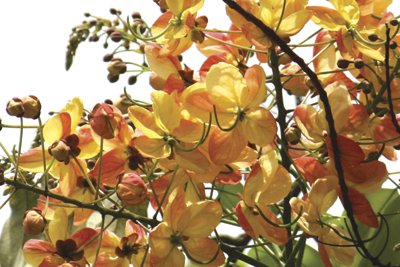Phuket Gardening – Cavalcade of Cassias

PHUKET: With the tennis season in full swing, sports addicts are hitting the covers off yellow balls, or watching day-glo missiles hurtle over the net on TV. Yellow is, apparently, more visible than the conventional white of my tennis-playing days.
Yet this most vibrant of colors has plenty of negative associations. Yellow has traditionally been the color of cowardice, a skin-borne indicator of illness, or of terminal decline. Macbeth, awaiting his meeting with destiny, declares he is “in the sere, the yellow leaf.” In the world of insects, the color is a warning to steer clear of creatures too poisonous to meddle with.
Flowers are blissfully unaware of such connotations. They just blaze away, adding their brilliance to our gardens and avenues. There are enough yellow fellows in Thailand to fill a sizable book.
Take the cassia brigade, more than a hundred strong. One, C. fistula, also known as the golden shower tree, took center stage on a TV soap opera a few days ago.
The tree was a mass of blooms, and so abundant were the vivid yellow racemes you could not even see the foliage. The characters canoodling beneath were not only caressed by falling petals, they were positively upstaged by the tree’s golden opulence.
Cassia used to be a much larger genus. Now re-classified, it still contains more than a hundred species. C. fistula is a signature tree on Phuket, a visible presence both on roadsides and in gardens. Thais call it khuun.
Though it will sometimes take from half-hardened cuttings, it is easier to grow from seeds soaked in water. They are easily obtained, since the plant is leguminous, and has long, cylindrical, dark brown pods. An ideal garden tree that likes full sun and moist well-drained soil, it is one of those smallish, fragrant, decorative trees that every gardener should crave.
C. brewsteri is not Asian, but an Australian native – which probably explains why it is uncommon here. It has similar drooping clusters of small yellow flowers, sometimes tinged with orange. Unlike fistula, which possesses attractive grey bark, this species has blackish branches.
Not all members of the clan are yellow flowering. C. javanica, which sometimes carries the name of pink shower tree, has graceful pinnate leaves that droop when young, and impressively large blooms (up to two inches across). Their coloration varies from buff through pink to crimson. Another small tree, it is frequently used to lend color to avenues and public spaces. A cultivar, “rainbow shower” is even more spectacular, with flowers that develop orange tones before turning to cream.
Many other cassias are listed in one of my gardening books, but the general view now is that most of these should be re-classified as sennas. The confusion is understandable. Cassias and sennas both have fern-like, pinnate leaves, almost all are evergreen, and the majority have showy yellow flowers that typically occur in clusters. Since they are all legumes, the fruits are large, long pods.
Many of these species have medicinal qualities. Indeed, I recall my distaste for senna pods as a child, then used as a laxative. Its important chemical properties are now more widely recognized – in the treatment of ringworms, for example. Best known among these is senna alata (formerly cassia alata). But alata is an American native. For species which will light up our Phuket gardens with their golden florets, we will need to consider senna siamea or didymobotrya.
Tip of the week – Trees for the garden
Trees are the backbone of your garden, providing shade and shelter, and bringing year-round appeal through their leaves, fruits, flowers, scent, bark, and overall appearance.
Typically, they are tall plants with one dominant trunk topped by a crown of foliage, whereas most shrubs are smaller, and have leaves all the way to the ground.
You need to decide what kinds of trees are best for your space. Do you want them primarily for their flowering capacity (michelia, plumeria, cassia, thevetia, senna), for their edible fruits (longan, mango, avocado, rambutan, pomelo,guava, lime) or for their attractive foliage or unusual shape (palm, casuarina, Norfolk pine)?
Or you may want fast growers (fiddlewood, neem), but these are likely to be heavy feeders, and once established, may need frequent pruning. Phuket Gardening is Patrick Campbell’s regular column on all things flora.
If you have a question or a garden that you would like featured, you can email the author here.
Keep checking our online Phuket Lifestyle pages or join our Facebook fan page for regular gardening features and tips.
— Patrick Campbell
Latest Thailand News
Follow The Thaiger on Google News:


























